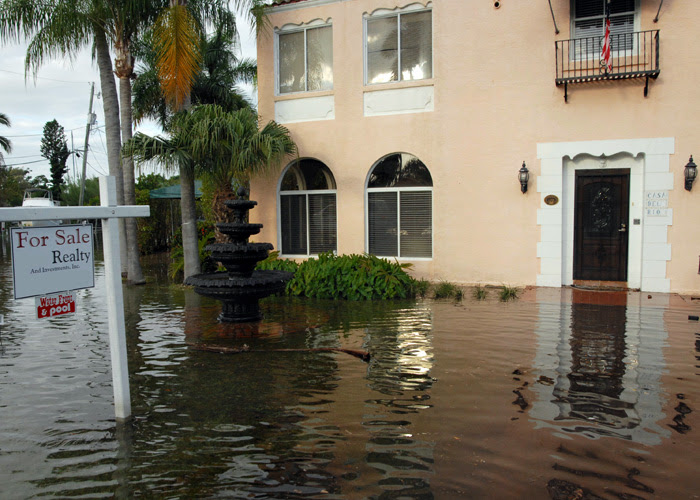Adapt to Rising Seas? Sure, but Not in My Neighborhood
Flooding may be the greatest cause of property damage throughout human history. Heavier rainfall and rising sea level have made flooding much worse in recent years. More and more people and communities are noticing that something is different than just decades ago. It is clear that we are in a new era, as the planet warms melting polar ice to new records, raising sea level. Future flooding will be even worse. Adaptation sounds good in principle, until it hits where we live.
As I show in the articles on my NEWS page, and in my weekly digest “Sea Level Rise Now”, cities from Miami to San Francisco to Shanghai are struggling to adapt to increased flooding. A few are even considering designs for a substantial three feet (~ 1 meter) of higher sea level by mid century. Yet the truth is that we need to “think bigger.” The latest US government study looked at worst case projections of up to eight feet by the year 2100. This week California established ten feet as the worst case scenario. With other risks, like earthquakes or tsunamis we are dealing with possible events. With rising sea level, it is only a question of how soon.
As the melting in Greenland and Antarctica continues to accelerate, the projections may well go even higher. Important efforts to slow carbon dioxide and other “green house gas” emissions, could retard melting and slow the rate of sea level rise somewhat. Regardless, we seem committed to at least four or five feet of sea level rise this century, posing a HUGE threat to homes, commercial buildings, transportation, streetscapes, and infrastructure in low-lying coastal communities everywhere. Even if we stop all carbon emissions today, sea level will still rise for centuries due to the excess heat already stored in the ocean. Adapting to rising sea level and shifting shorelines is the safest possible investment. At worst, we will build higher than necessary for the short term, but comforted to know that the sea will get to that height sooner or later.
Adapting to ever rising sea level may be our greatest challenge ever. How do we have functional, appealing communities that can deal with ever more unusual weather patterns, intermittent flooding, and slowly rising, but essentially permanent sea level rise? The point of friction — where the rubber meets the road –comes at the street level, and down to one’s own property.
I work with lots of professionals, architects, engineers, planners, as well as cities, large corporations, and national security agencies, helping them to understand and plan for rising sea level. In those circles, there is growing acceptance that flooding is at record levels, and trending higher. But in the wider society, our sense of land being permanent, our sense of attachment to place, and our dislike for disruption is so strong that we are extremely resistant to change. It may sound like a great idea to raise homes, roads, infrastructure and businesses until it “hits home.”
Just as one well known example, Miami Beach is vulnerable to this challenge. Vast areas were flooding every twenty eight days with the full moon high tide, pushed ever higher as sea level has risen. The City boldly started on a plan to install four hundred million dollars of pumps, drainage pipes, and raise street elevations. Many residents complained about the pumps being unsightly. The city persisted and the streets are starting to flood less, though even they admit the solution is a short-term fix, that may delay the flooding for a few decades. Many efforts have unintended consequences. For example, raising the level of one street or building lot, causes the water to flood adjacent properties.
Last week an article in Fort Lauderdale’s SUN SENTINEL newspaper described the challenge of how to get homeowners to raise their houses and reduce flooding. Residents who want to renovate their homes beyond the 50% level, are being required to elevate them, to reduce their vulnerability. As the article cites, that too is causing an outcry because residents want to improve their homes without raising them higher. Some of the high value communities in South Florida are pushing on local government to solve the flooding problem, yet don’t want adaptions to spoil the ambience, the “pedestrian experience”, or historical character.
It’s not just Florida. As another example, in quaint Annapolis Maryland, both the city and the iconic US Naval Academy, are struggling to preserve their history and deal with the wharf flooding that is now happening about 40 days a year, instead of just four days a year, a ten fold increase in past fifty years.
There is no easy solution to rising seas. Adaptation approaches will need to vary by locale. But the longer we “kick the can down the road” the tougher this will be to solve. Delay ensures disaster. Even though painful, the sooner we begin to design and implement higher elevations the better. We can and should look to architects and engineers for innovative solutions. But ultimately bold action will take political and social leadership, and that requires support from the public — which is us. Which reminds me of a famous cartoon from a half century ago. Walt Kelly’s POGO is best known for the phrase:
“We have met the enemy and he is us.”
Though this may be the first time that civilization has had to adapt to rising sea level, we need to deal with the situation that confronts us. Frankly adaptation to the rising sea is not optional. We will adapt, either with planning and design, or through crisis and catastrophe. The ocean is indifferent to our prejudices, politics, beliefs, or wishful thinking. Hopefully we will rise with the tide.

